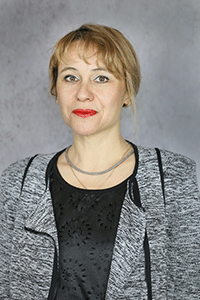Understanding ocean-sea interactions during tropical cyclones using passive acoustic monitoring: Gulf of Mexico case study - Physics
Colloquia Topic and Speaker Bio

Bio: Natalia Sidorovskaia is the Coca-Cola/Board of Regents Endowed Professor of Physics and the Chairperson of the Department of Physics at the University of Louisiana at Lafayette. She received a M.S. degree in radiophysics from Gorky State University. After four-year research appointment at the Institute of Applied Physics of the Russian Academy Sciences, she moved to the USA and received a Ph.D. Degree in Engineering and Applied Science from the University of New Orleans. After a two-year career in industry with Landmark Graphics Corporation (Halliburton Company), Natalia joined the Department of Physics at the University of Louisiana at Lafayette in 2000. Her research interests focus on experimental and computational underwater acoustics, signal processing, big data analytics leading to understanding sound propagation and scattering, marine mammal acoustic communication and interaction with the environment, and impact of humans and climate change on oceanic ecosystems. She is a Fellow of the Acoustical Society of America and a member of the Sigma Pi Sigma National Physics Honor Society. Natalia was named a 2020-2022 ACE Fellow by the American Council on Education (ACE) with the University of Pittsburgh as a Host Institution.
Abstract: Air-sea interaction processes define many prominent features of the acoustic ambient noise spectrum in the ocean (Wenz, 1962). Therefore, underwater acoustic field measurements have demonstrated a substantial potential in monitoring wind speed over the ocean. Shaw et al. (1978) pioneered the field by establishing a linear relationship between the underwater sound pressure levels and the logarithm of low to moderate local wind speeds. Later, Wilson and Makris (2006) further advanced the theory by proposing a parameterized acoustic notional surface source model specifically designed to estimate high wind speeds during tropical cyclones. However, even in the Gulf of Mexico region, that is heavily impacted by hurricanes, acoustic data input is not routinely used to track cyclones’ wind speeds. The talk will discuss several approaches to the analysis of the acoustic data collected by the bottom-anchored passive acoustic monitoring system during storm Barry (2019) in the Gulf of Mexico to estimate local wind speeds. The estimated wind speeds are compared to the high-resolution ones generated by the Weather Research and Forecast model. Recently, underwater gliders equipped with passive acoustic systems in addition to traditional set of environmental sensors have been emerging as a new tool for understanding the marine conditions that influence the onset and amplification of tropical cyclones. In this context acoustic data could aid in refining wind strength forecasting, thereby aiding in high spatial resolution wind mapping during hurricanes. Fully autonomous glider’s reconnaissance may also offer a new type of field data (acoustic) to integrate into the operational weather forecasting models used by NOAA and U.S. NAVY for more reliable cyclone strength prediction. [Research supported by the Office of the Under Secretary of Defense for Research and Engineering, award# FA9550-21-1-0215]
